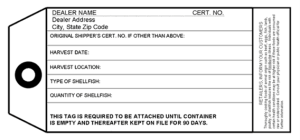Seafood is one of those foods people find delicious and a special treat when dining out. Many cultures have it as a mainstay of their meals. Seafood can be a nutritious part of a well-balanced and varied diet.

This blog will focus on oysters. You either love them with lime, salt, and tabasco sauce (or other ways) or avoid them like the plague. Eating raw oysters comes with some risks. Consuming raw oysters may cause a foodborne illness called Vibriosis caused by Vibrio bacteria.
We have seen in the news that you can get seriously ill and even, in rare cases, die from eating raw oysters contaminated with Vibrio – a bacteria commonly found in waters where oysters are cultivated.
“If you consume raw oysters, you should know about Vibrio. Any time you enjoy oysters raw, there is some risk of contracting vibriosis, especially for those that are immunocompromised. Vibrio, which includes species such as vulnificus, parahaemolyticus, and alginolyticus are found in higher concentrations during the summer months as water becomes warmer. About 80% of the infections happen between May and October and can be very dangerous to human health.” – Keith Schneider, UF/IFAS Extension, Professor Food Safety, Food Science and Human Nutrition Department
Oyster harvesting areas are monitored by FDACS, which is the Florida Department of Agriculture and Consumer Services. They provide an informative map to show locations where shellfish harvesting is allowed. https://fdacs.maps.arcgis.com/apps/webappviewer/index.html?id=57f7d4b7d900496d99891f22681c66d0
You can’t tell if an oyster is contaminated by a harmful microbe just by looking at it, tasting it, or smelling it. Most healthy people can fight off the Vibrio infection, but it can be deadly if you have underlying conditions, especially a suppressed immune system. People who are immunocompromised should be cautious about ordering and consuming raw oysters. Diabetes, cancer, HIV, stomach disease, or any illness or medical treatment that weakens the body’s immune system can also put individuals at high risk for Vibrio infection. To learn more, read these frequently asked questions. https://www.cdc.gov/vibrio/faq.html

Many restaurants have signs in the building and notations printed on menus warning diners that eating raw shellfish may increase their risk of foodborne illness. Heed these warnings carefully. Be informed and aware of the risk.
Menus will alert people with a consumer advisory, with the following type of statement or something similar: “Consuming raw or undercooked meat, eggs, poultry, or seafood increases your risk of contracting a foodborne illness, especially if you have certain medical conditions. There may be a risk associated with consuming raw shellfish as is the case with other raw protein products. If you suffer from chronic illness of the liver, stomach, or blood illness, or have other immune disorders, you should eat these products fully cooked”.
Symptoms-How do I know if I have a foodborne illness caused by Vibrio?
Potentially life-threatening to some people, symptoms of Vibrio infection may occur within approximately 4 to 36 hours of eating raw oysters and can include symptoms such as sudden chills, high fever, nausea, vomiting, abdominal pain, or watery diarrhea. Anyone showing signs of these symptoms after eating raw oysters should seek medical attention immediately and inform their health care provider that they have eaten raw oysters. When in doubt, call your physician. Don’t wait!

Reducing the risk of Vibrio infections
Oysters should always be obtained from reputable sources. Eating oysters from clean waters or in reputable restaurants with high turnover does not necessarily provide protection. Many people believe that by adding lime juice or hot sauce to raw oysters, this practice can kill bacteria. This is not true! The truth is that only cooking at a high enough temperature can destroy the bacteria. The next time you want to eat and enjoy oysters, consider cooking them thoroughly when dining at home or order cooked by the restaurant when eating out.

Tips for Eating Oysters
In general, it’s better to eat cooked shellfish to avoid any type of foodborne illness. It is important to follow the recommendations from the experts and from the research that has been conducted. Food safety is very important to us all. Cook shellfish thoroughly. Remember the basic principles of clean, separate, cook, and chill. Always wash your hands for at least 20 seconds with soap and water before and after handling foods and engaging in food preparation. Avoid handling the raw shellfish if you have an open wound on your hand. If the wound comes in contact with raw oysters, clean it immediately and monitor the wound for signs of infection.
- At restaurants–Consider ordering oysters fully cooked if you are concerned about foodborne illness, especially if you are immunocompromised.
- Purchasing-Do not purchase the oyster if the shells are open, and always ask for a certified shipper’s tag to ensure that the oysters have been harvested legally from an approved body of water. You can also find detailed information on the date of the harvest on the shipper’s tag. See an example of the tag below.

At home: Throw away any oysters with shells already opened.
In the shell: Boil until the shells open and boil live oysters for another 3-5 minutes. Do not cook too many oysters in the same pot because the ones in the middle may not get fully cooked. Discard any oysters that do not open during cooking. https://www.fda.gov/food/health-educators/vibrio-vulnificus-health-education-kit-fact-sheet
- Cooking Choices for Shucked Oysters-Boil or simmer shucked oysters for at least 3 minutes or until the edges curl. Fry in oil at 375 degrees for at least 3 minutes. Broil 3 inches from heat for 3 minutes. Bake at 450 degrees for 10 minutes.
“Be safe! Check the certified shipper’s tag and remember to discard any oysters that do not open during the cooking process. Quick steaming or cooking until the shell is open is not enough to protect you from Vibriosis. Protect yourself from foodborne illness.” –Razieh Farzad, UF/IFAS Extension Assistant Professor and Seafood Safety Extension Specialist, Food Science and Human Nutrition Department and Florida Sea Grant

Here you can find more information on guidelines and tips for cooking shellfish: https://www.cdc.gov/vibrio/prevention.html Make sure to cook food to the recommended internal temperature. Avoid cross-contamination of cooked foods with raw seafood or juices from raw seafood. Disinfect all contact surfaces and utensils properly to help prevent infections and avoid foodborne illness.
It is important to eat a variety of fruits, vegetables, grains, dairy, and protein foods as part of a healthy diet. Protein foods include foods such as seafood, lean meats and poultry, eggs, legumes, soy products, seeds and nuts.
Stay safe and maintain good health!
Read more. Learn more.
UF/IFAS Extension, Preventing foodborne and non-foodborne illness: Vibrio parahaemolyticus- https://edis.ifas.ufl.edu/pdf/FS/FS146/FS146-13646651.pdf
Raw oyster myths- https://www.fda.gov/food/health-educators/raw-oyster-myths
Fight Bac/Partnership for Food Safety Education- https://www.fightbac.org/sign-up/?gclid=EAIaIQobChMItKbrrazT-QIVGebjBx2OcALcEAAYASAAEgJ1IfD_BwE
MyPlate/Protein Foods- https://www.myplate.gov/eat-healthy/protein-foods
The danger of eating contaminated raw oysters- https://www.fda.gov/food/health-educators/danger-eating-contaminated-raw-oysters
Engaging in food safety behaviors does matter- https://blogs.ifas.ufl.edu/browardco/2022/02/08/engaging-in-food-safety-behaviors-does-matter/
#Food is our middle name.
An equal opportunity institution.
 3
3
